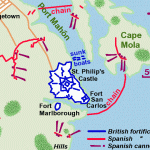The Loss of Minorca
In 1763 the island of Minorca had been ceded, for the second time, to Great Britain at the end of the Seven Years War. In 1771 the 61st Foot were posted there as part of the small British garrison. The American Revolution quickly led to Britain being again at war with her old colonial rivals, France and Spain, and in August 1781 a Franco-Spanish expeditionary force of around 16,000 men descended upon Minorca to wrest it from the British. The British garrison, around 1,500 strong, was quickly bottled up in Fort San Felipe, and the long siege began.
 The garrison held out until early the following year, when starving and much reduced in numbers, General Murray was obliged to surrender, with full honours of war. Murray wrote in his despatch to London: “The Siege endured until 5th Feb. 1782, when the garrison, worn out by the severity of their duties and dreadfully diminished by the fearful ravages of scurvy, were obliged to capitulate. They could no longer furnish men for the several posts. The necessary Guards required 415 men, and on the night before the capitulation only 660 able to carry arms could be mustered. Of these no less than 560 were infected and would in all probability soon have to be taken to hospital. “The extent of the suffering endured by the troops during the siege has rarely been equalled; their constancy and fortitude never excelled. Men died on guard and their dangerous illness was only discovered in death by the reliefs who consciously left a fresh victim as they removed the stiffening corpse of the last. Yet none would go into hospital: none talked of surrender. “Men in indomitable spirit enabled them to conceal their disease, but neither bravery nor determination could resist their fate.
The garrison held out until early the following year, when starving and much reduced in numbers, General Murray was obliged to surrender, with full honours of war. Murray wrote in his despatch to London: “The Siege endured until 5th Feb. 1782, when the garrison, worn out by the severity of their duties and dreadfully diminished by the fearful ravages of scurvy, were obliged to capitulate. They could no longer furnish men for the several posts. The necessary Guards required 415 men, and on the night before the capitulation only 660 able to carry arms could be mustered. Of these no less than 560 were infected and would in all probability soon have to be taken to hospital. “The extent of the suffering endured by the troops during the siege has rarely been equalled; their constancy and fortitude never excelled. Men died on guard and their dangerous illness was only discovered in death by the reliefs who consciously left a fresh victim as they removed the stiffening corpse of the last. Yet none would go into hospital: none talked of surrender. “Men in indomitable spirit enabled them to conceal their disease, but neither bravery nor determination could resist their fate.
The dreadful hour was delayed to the last, but it came – only however when their obstinacy had well nigh annihilated them. “Perhaps a more noble or tragical scene was never exhibited than that of the march of the garrison of St. Phillip’s through the Spanish and French armies. It consisted of no more than 600 old decrepit soldiers, 200 seamen, 120 Hannoverians, 20 Corsicans, 25 Greeks, Turks, Moors, Jews etc. The two armies were drawn up in line, the battalions fronting each other, forming a way for us to march through. They consisted of 14,000 men, and reached from the glacis to Georgetown, where our battalions laid down their arms declaring they had surrendered to God alone, having the consolation to know the victors could not plume themselves on taking a hospital. “Such was the distressing figure of our marching that many of the Spanish and French troops are said to have shed tears as they passed them.
The Duc de Crillion and the Baron Falkenhayn declare it is true. I cannot aver this, but I think it very natural.” The garrison’s period of captivity did not last long, and they were well treated by their Spanish adversaries. In May 1782 the survivors of the 61st Foot disembarked at Plymouth, to a hero’s return.


